Climate Change Challenge
Enter our 2024 Creative Climate Change Challenge
Category 1: Produce a piece of creative work that highlights the theme of climate change.
Category 2: Produce a piece of creative work made entirely from recycled/repurposed materials.
This Year’s Entries
Vote for your winner
Hazel Tyler
I love polar bears but as they cling to ever decreasing icebergs in the earlier Arctic melts, they have less time to build up their fat stores making survival more difficult. It is feared we will lose these beautiful animals within 100 years if Global Warming continues at its current rate. We must help them survive.

Sarah Fox
Single-use plastic is produced from fossil fuels and this process creates huge amounts of greenhouse gases. They’re not biodegradable so can last for years without breaking down and can harm wildlife on land and in oceans. I created this plastic fabric using single use plastics I had at home, and included some of the messaging about how to recycle them to highlight how confusing it can be.
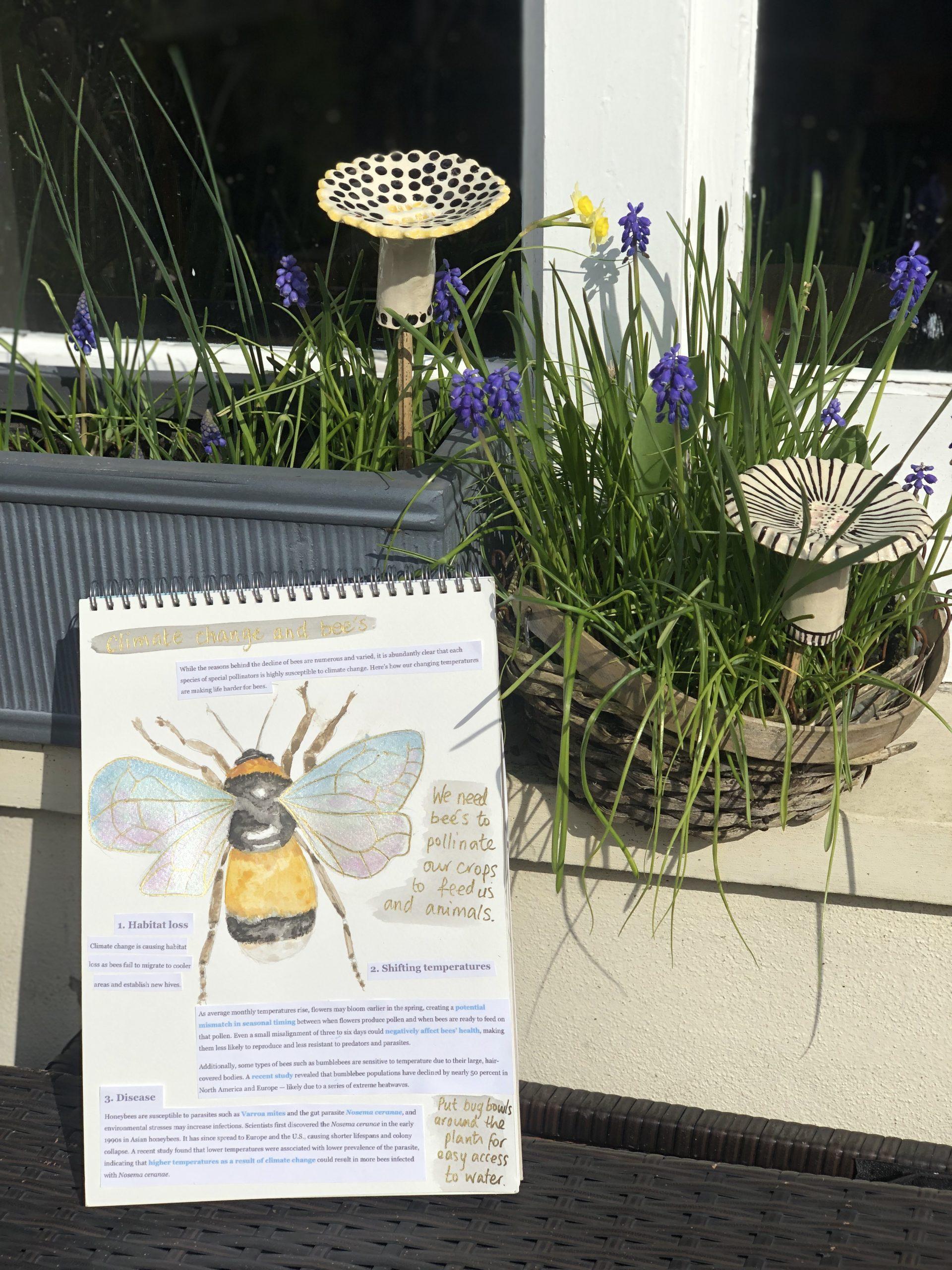
Jo Cutbush
Bee’s are declining in numbers due to the affects of climate change. Our changing temperatures are making life harder for bees and other bugs. We need these incredible little insects for survival, they pollinate our crops that feed us and animals. So to make life easier for them, I have hand made these little ceramic ‘bug bowls’ to put in our gardens, nestled amongst the bees favourite plants such as Lavender so when they are busy collecting pollen on a hot day they can get a drink easily, they are designed to hold just a small amount of water or food so the bee’s/insects are safe. I have used recycled clay and glaze them in all sorts of colours. In the photo I have included a watercolour painting of a bee and some words describing the affects of climate change on bee’s.
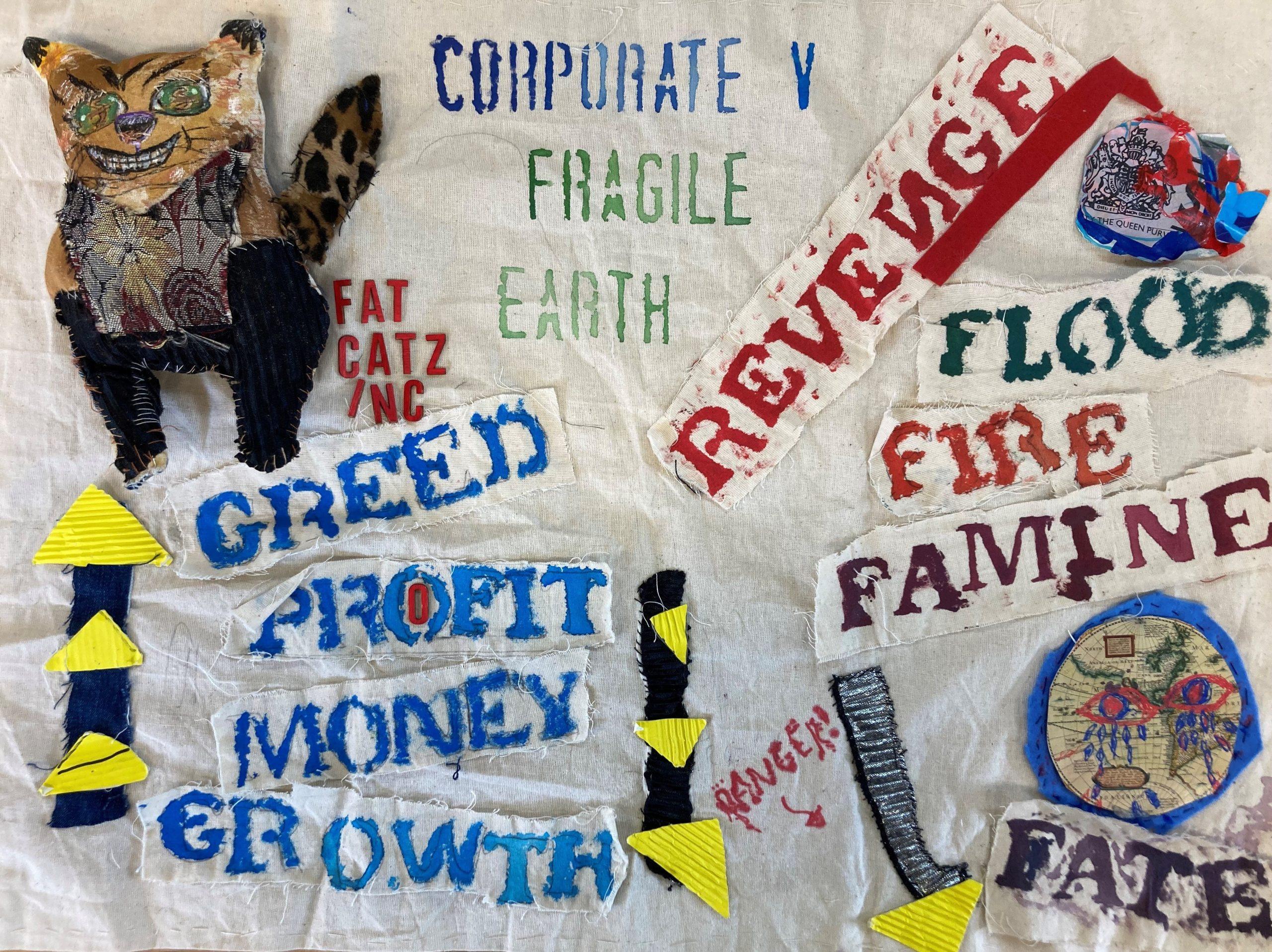
Gill Adams
I produced this piece using a range of fabric painting and stitching techniques. I wanted to draw attention to the effect that the large global ‘fat cats’ are having on our world.
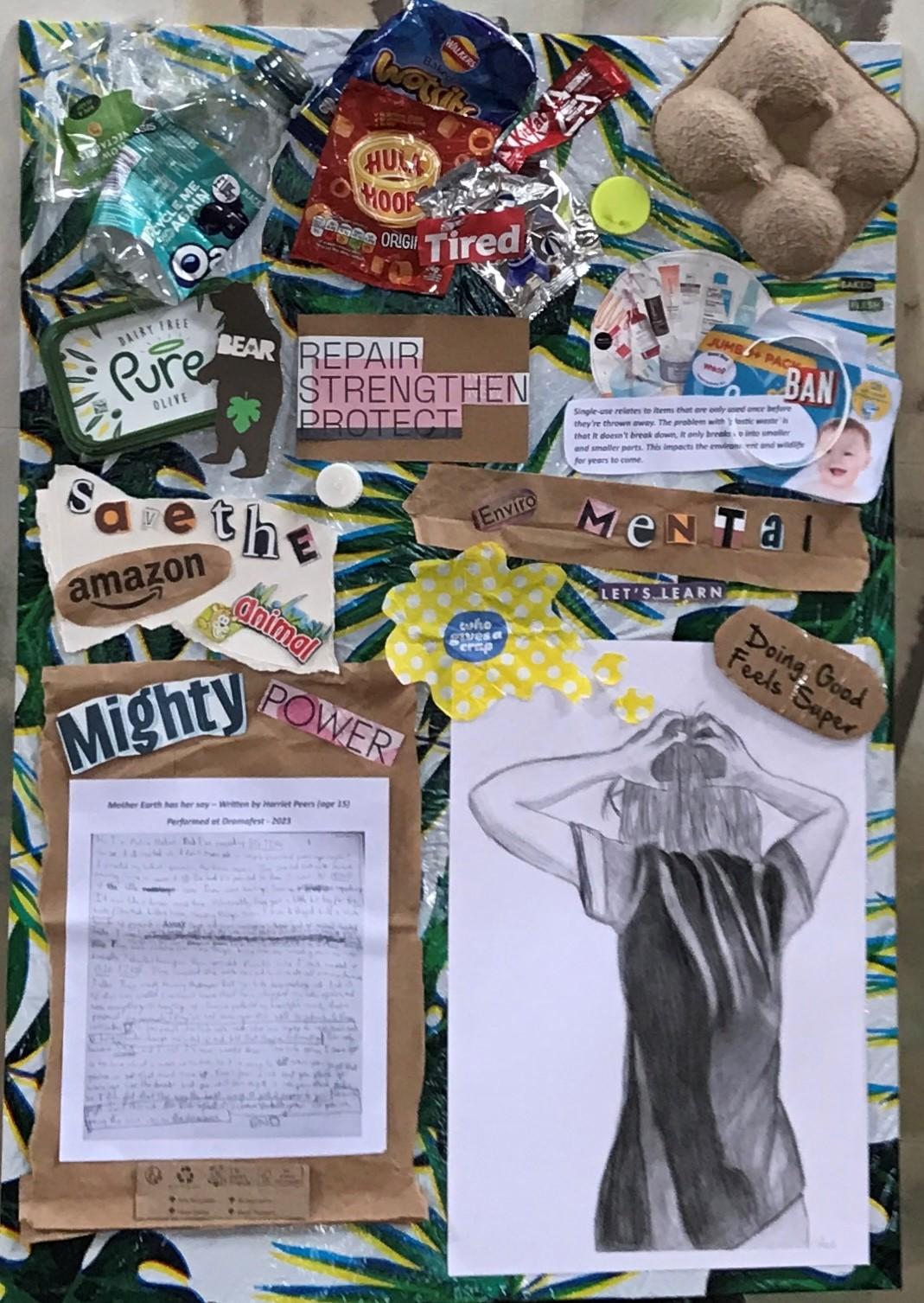
Toni Peers
I completed this piece as my final outcome for my Level 2 Art and Design Qualification, last year. I have been increasingly frustrated by the Reduce, reuse, recycle motto for changing the effects of climate change as it seems so passive. Here I presented ‘Repair, strengthen and protect’ as a better slogan – if we can use it for hair we should be able to embrace it for the climate crisis slogan. I am really pleased with the way the artwork came out, I enjoyed finding words from our recycling, to use to convey messages about the climate crisis. It was great to be able to adapt the artwork using my daughter’s words from something she wrote for Dramafest at the Mercury theatre – this is a crisis that most affects young people and her words are powerful – she is the young person I drew in the image shown.
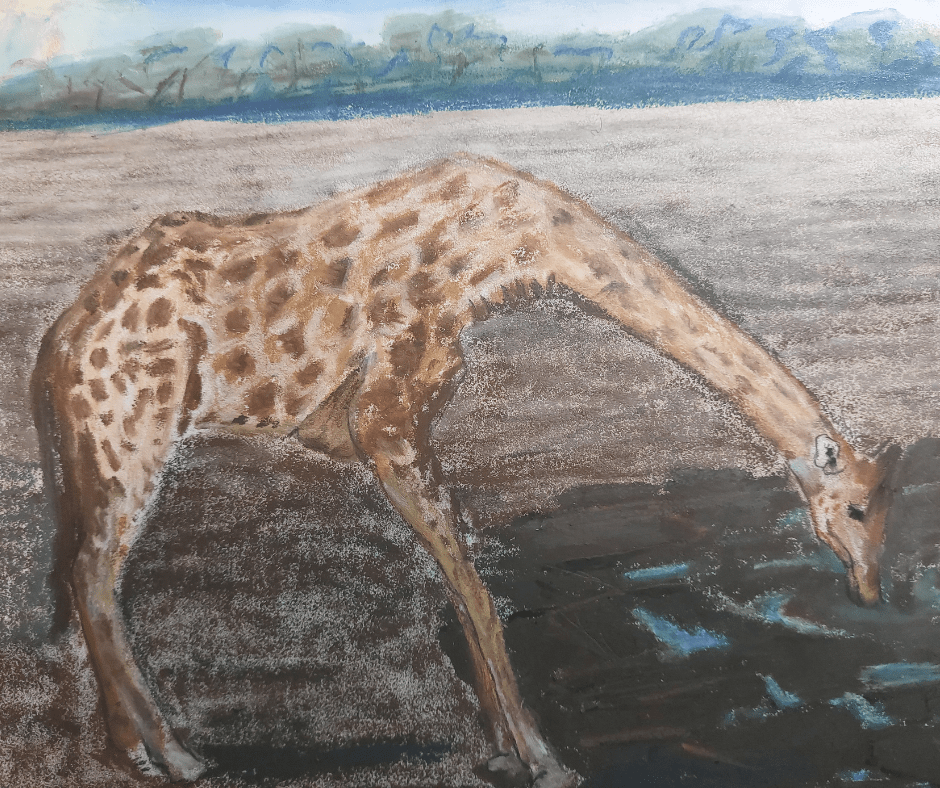
Barbara Hammond
Giraffe trying to find water in a dried out waterhole. Showing how increasing temperatures are damaging habitats and endangering wildlife.
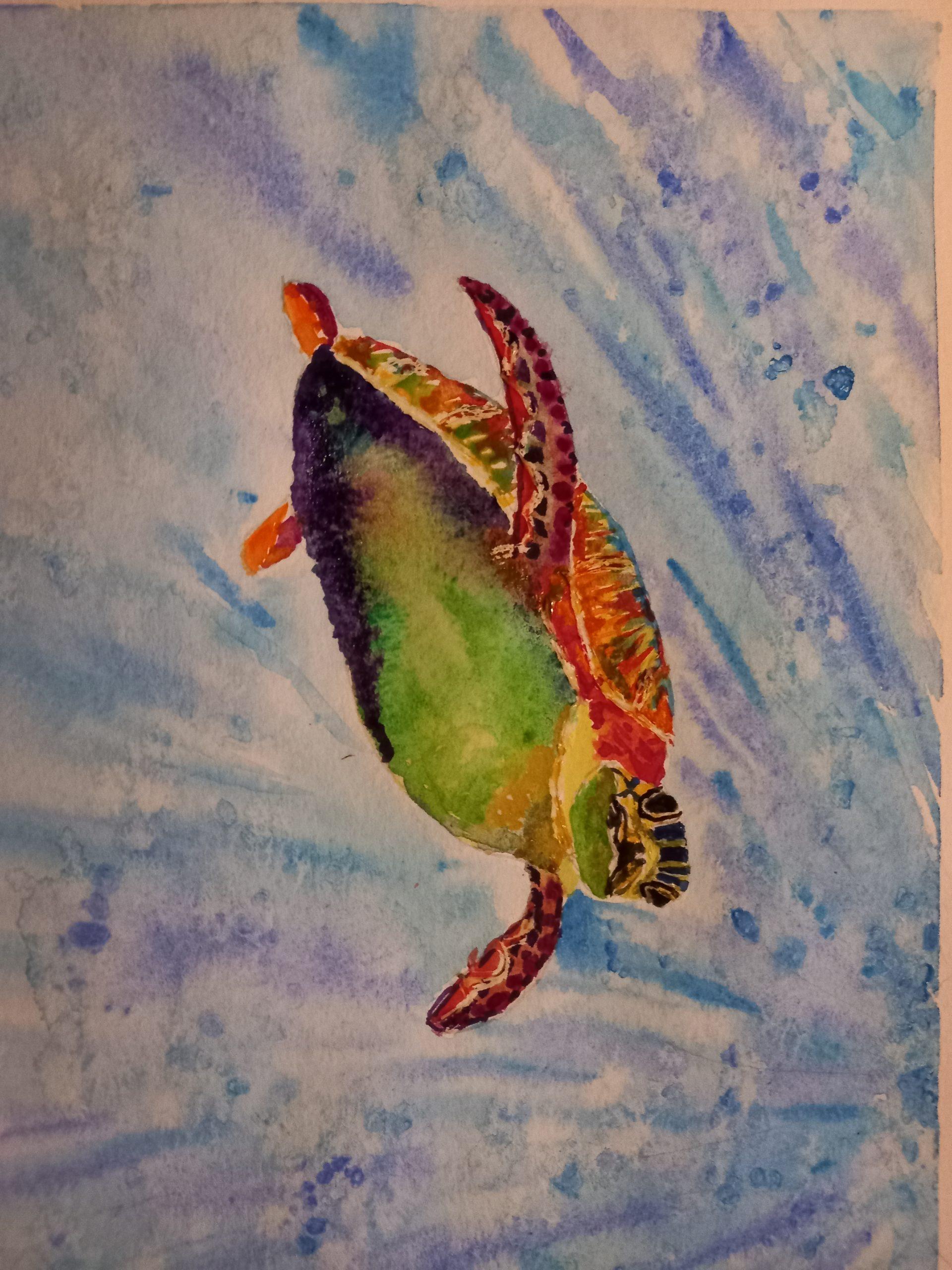
Yvonne McAulay
I watched a David Attenborough film and it inspired me to create this watercolour painting.
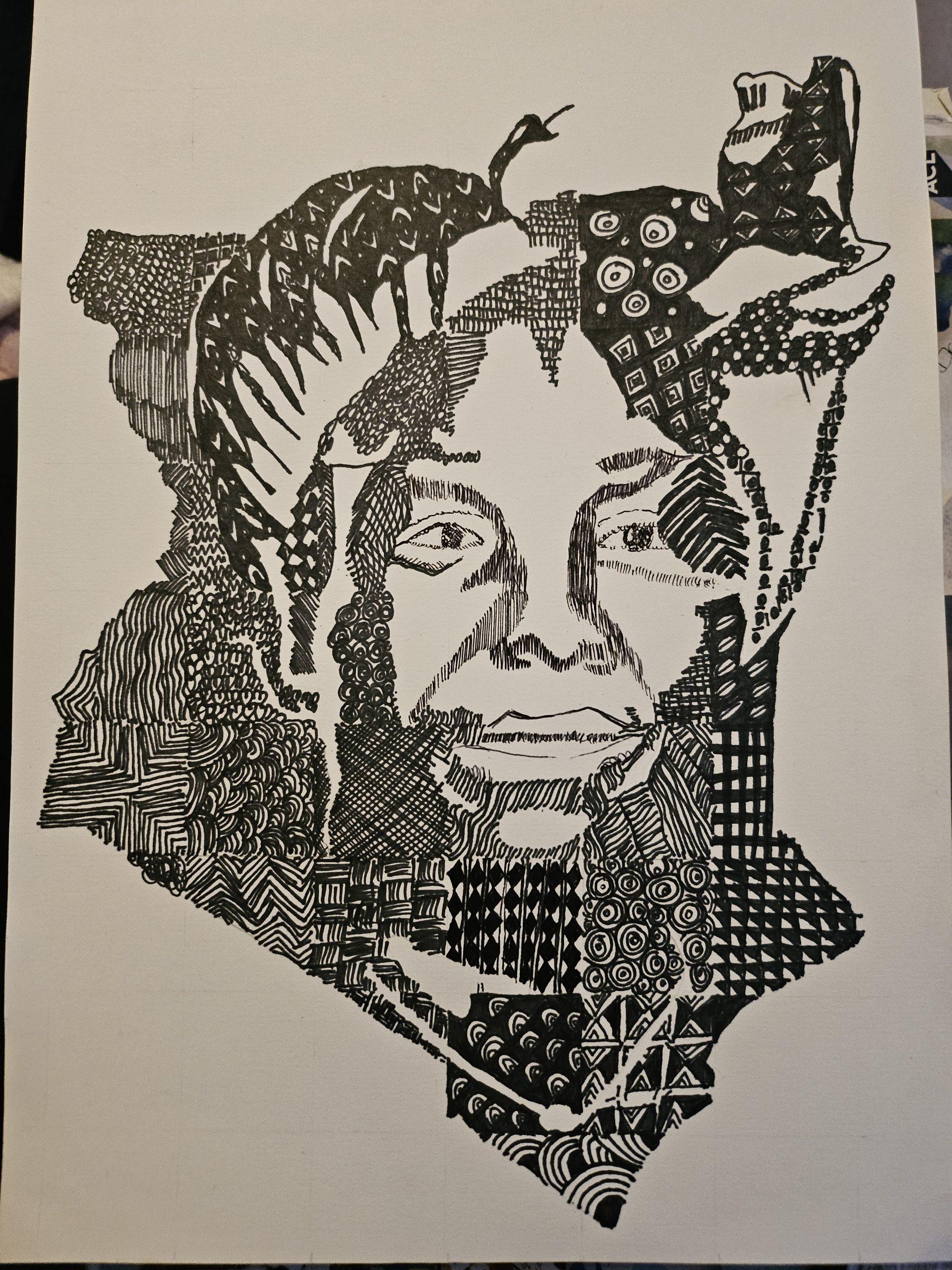
Jasmin Weller
Wangari Maathai she is recognized that the only way to reverse desertification was to plant trees. She is an inspiration and it was amazing to do a silhouette of her with patterns using the grid technique. I really enjoyed doing this piece of work in The Art for the Terrfied Class at ACL taught by Lucy Johnson.
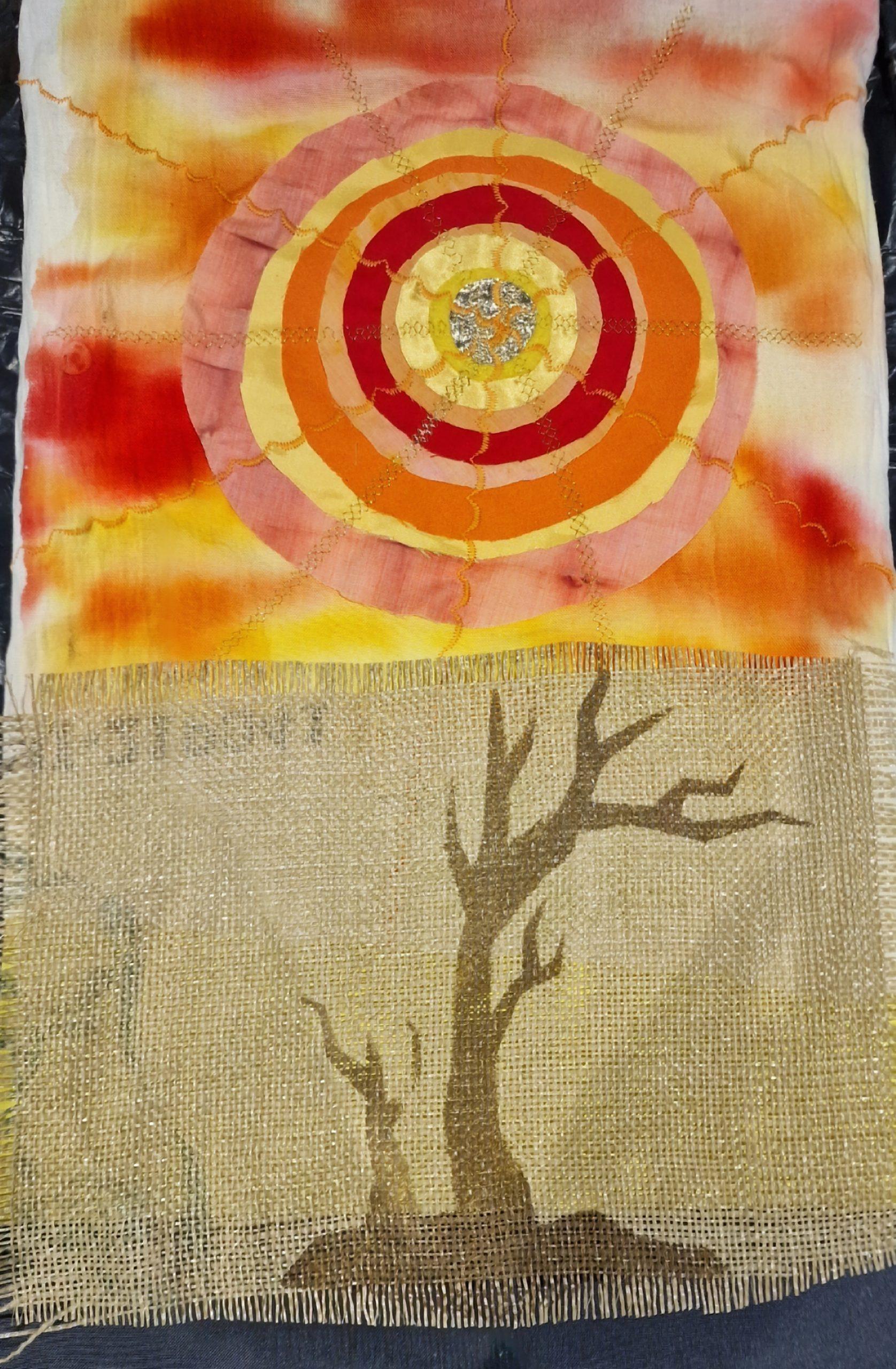
Carol Bukuku
When I thought climate change I immediately thought of the sun and the power it has over the earth to bring life but also prevent it through its extreme nature causing drought. My piece was made from scrap materials I had left over from previous projects and a hessian coffee bag. The sun was made by layering circular pieces of fabric and adding machine stitching to show the intensity of the sun on top of drop dyed white fabric. The tree was stencilled onto the hessian coffee bag.
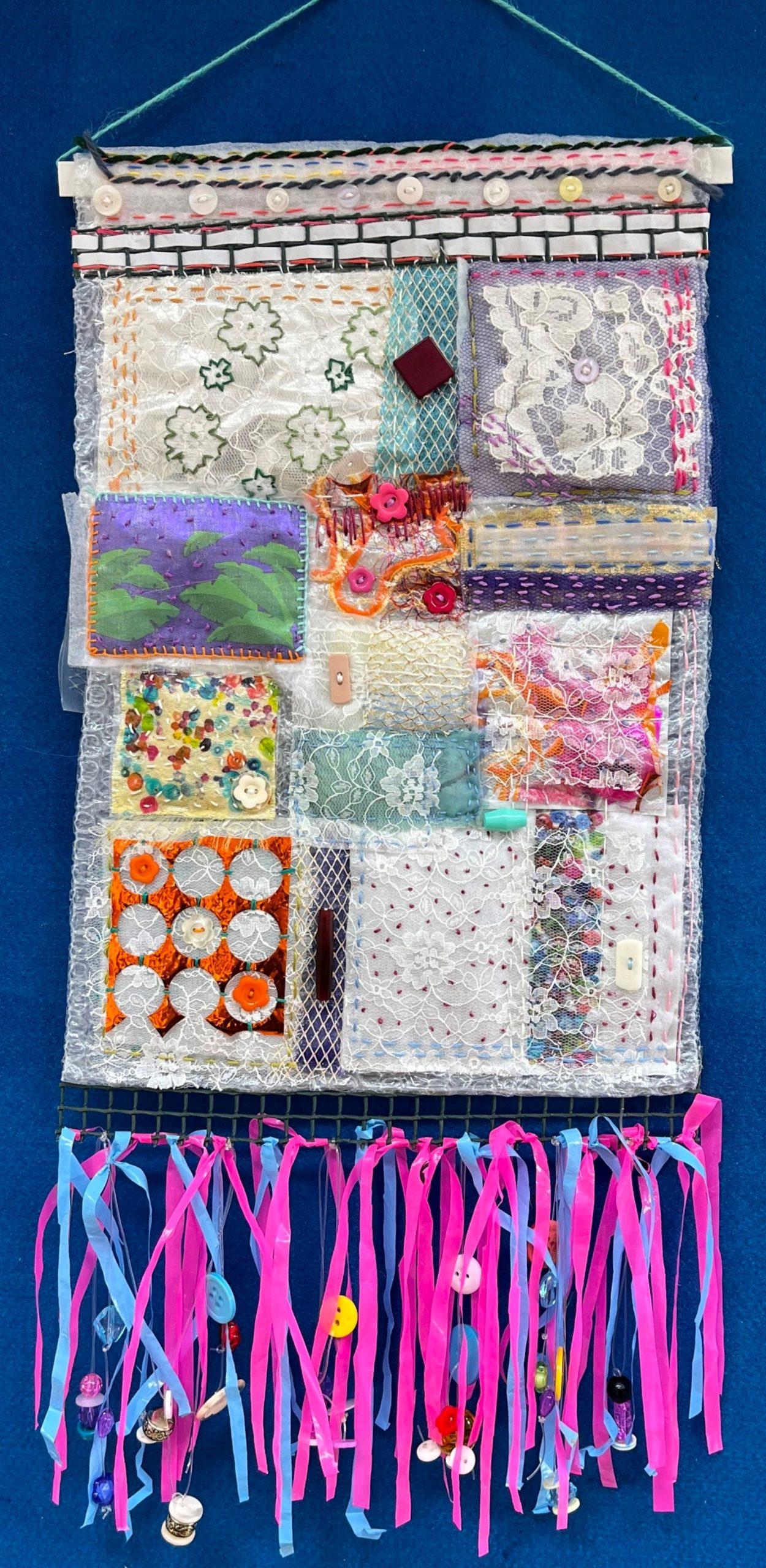
Lorraine Headley-Neill
I wanted to create something beautiful from waste. I made patches from bubble wrap, plastic wrappers, crisp packets and fused plastic bags; scraps of synthetic thread, lace and fabrics; as well as other bits from my bin. I have quilted the whole piece then added plastic bag fringing and odd buttons and beads.
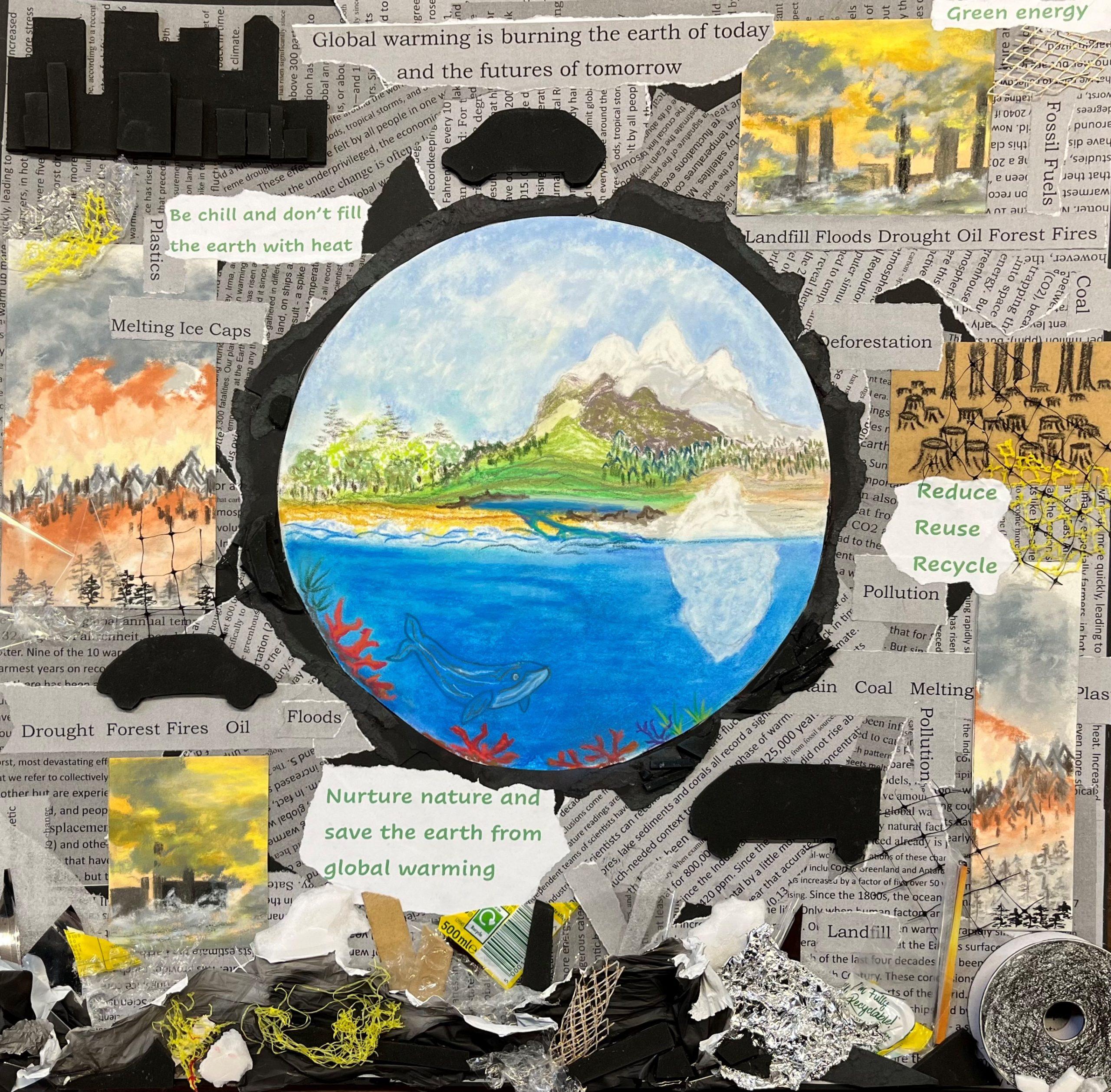
Lorraine Headley-Neill
I wanted to show the impact of climate change on our Earth and what we can do to reduce this. I completed a collage with pastel paintings and waste materials from my bin.
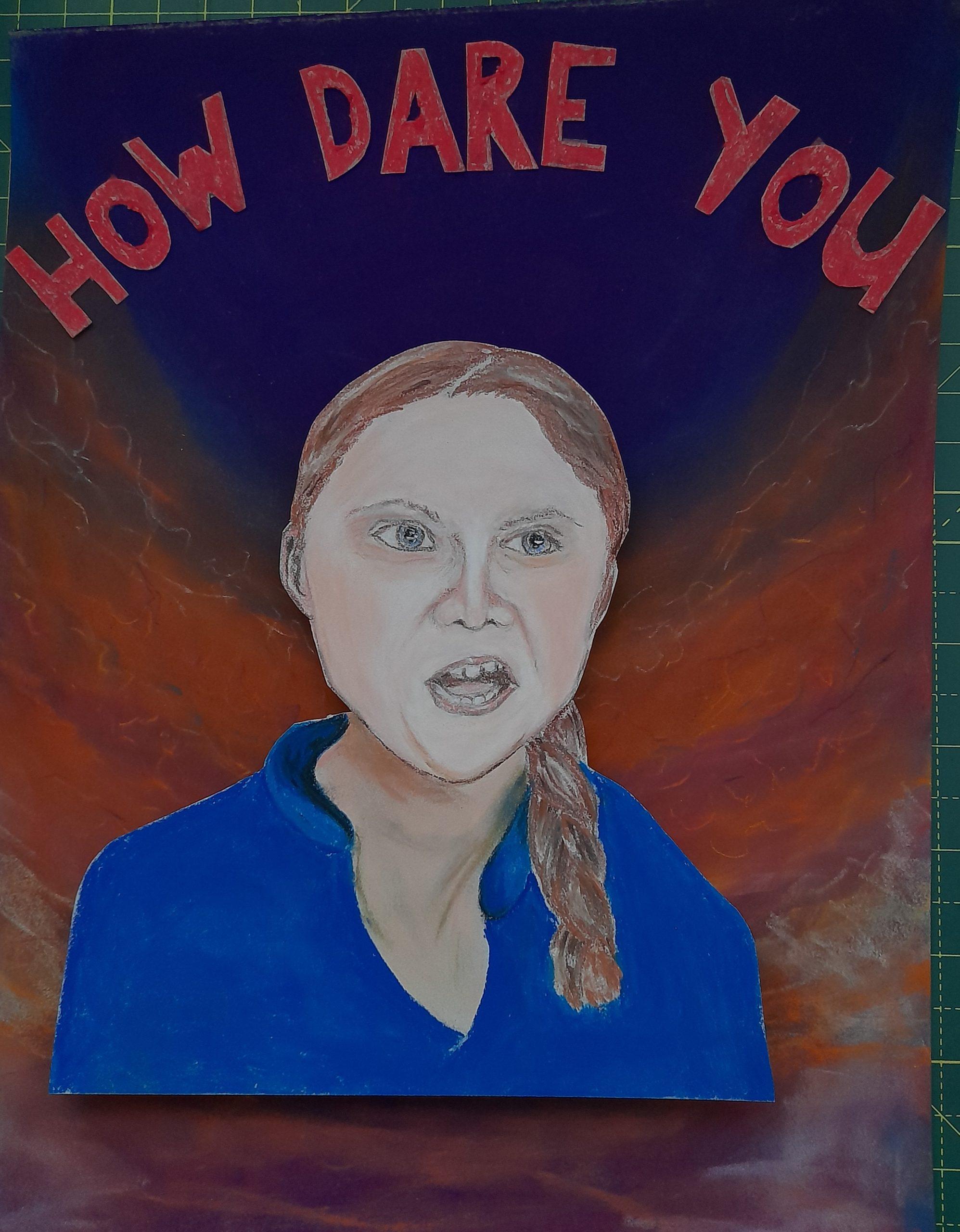
Valerie Gould
Greta Thunberg inspires me with her anger against governments and big business due to their greed and lack of interest in doing anything meaningful to halt the increase in carbon emissions and associated climate change.
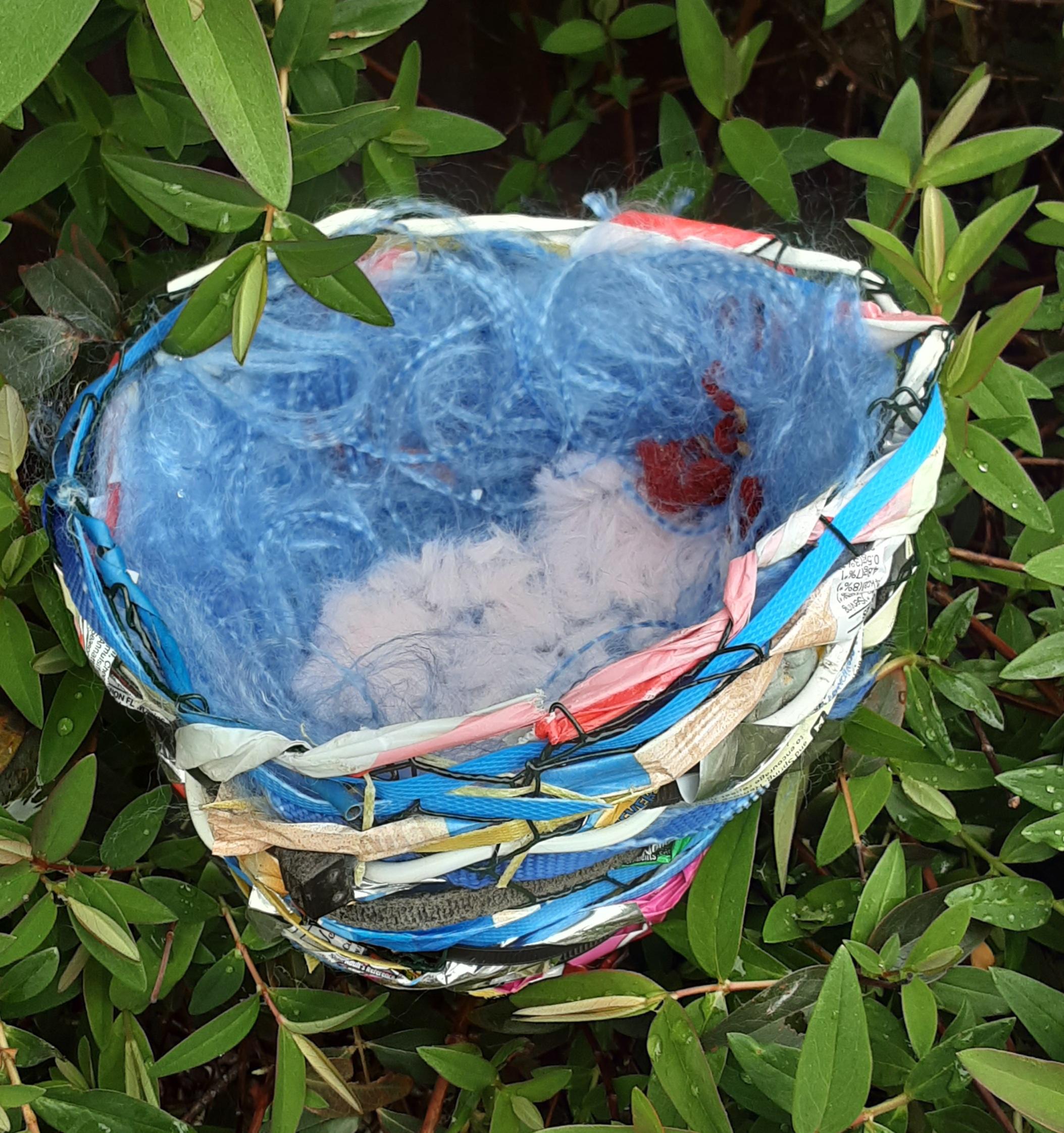
Melanie Isabel Ferris
I have made a bird’s nest to highlight habitat loss for hedgerow birds. I went for an afternoon walk round the lanes near me and collected discarded litter from the ditches and gutters. There are crisp packets, straws, parcel strapping, cable ties, and webbing. All the material in the nest was sourced from that one walk.

Yumiko Rainer
A portrait of Wangari Maathai – an African environmental campaigner.
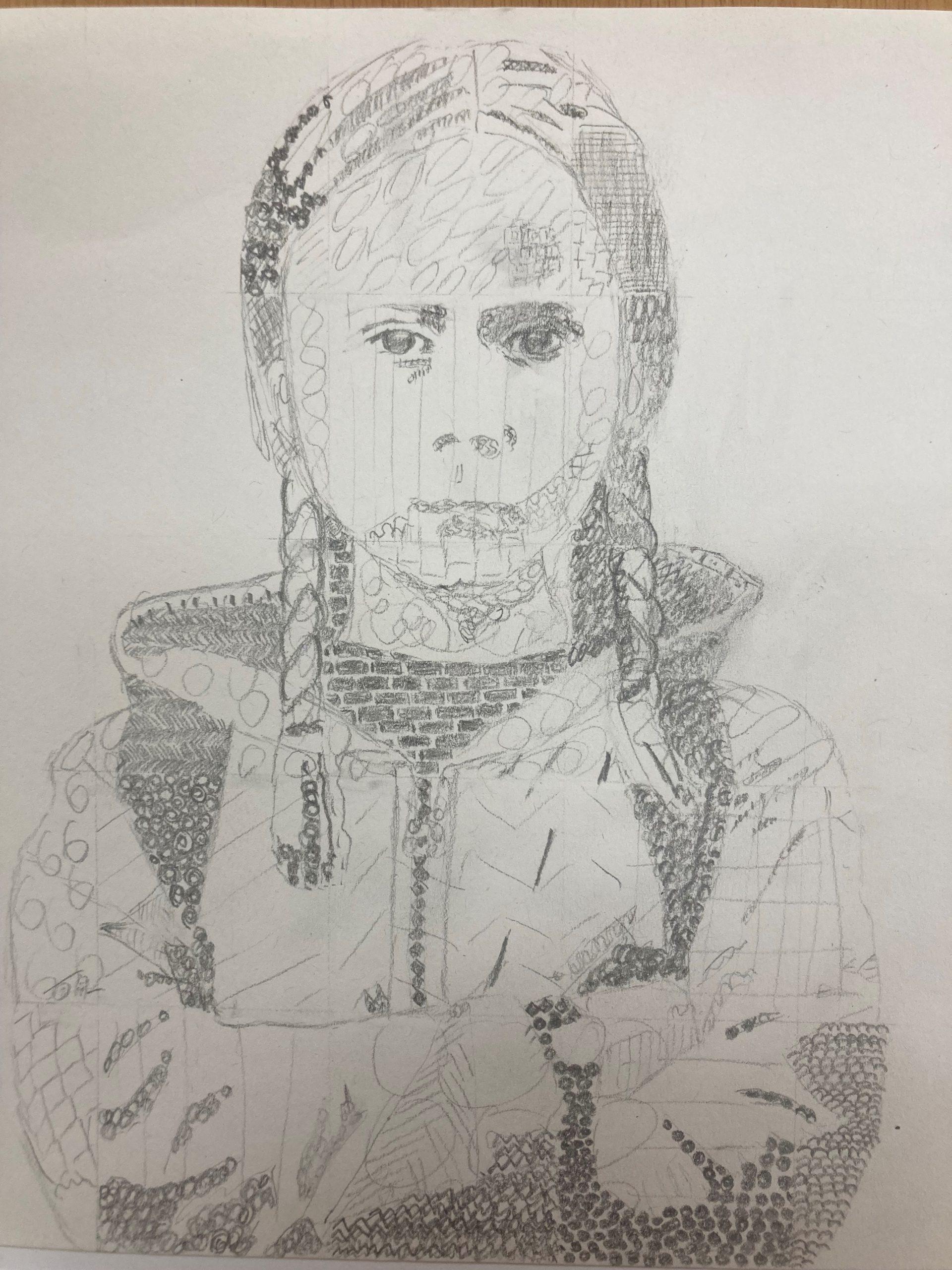
Alex Mashadi
A portrait of Greta Thunburg where I have explored creating a range of marks and patterns in pencil
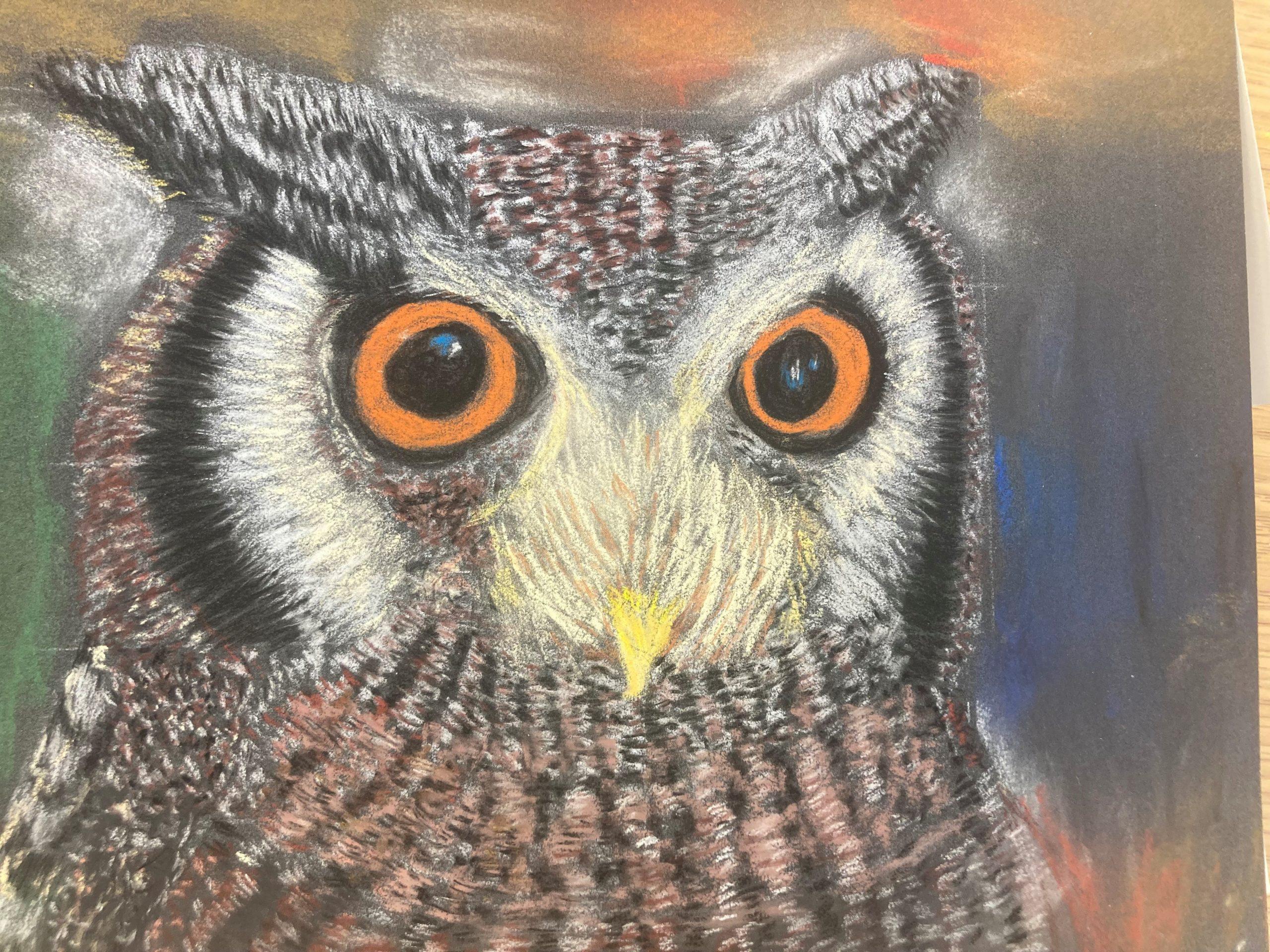
Joan Adams
I have produced this piece in pastels and pastel pencils on pastelmat paper. In my piece I wanted to highlight the effect that the loss of habitat is having on so many animals including owls.
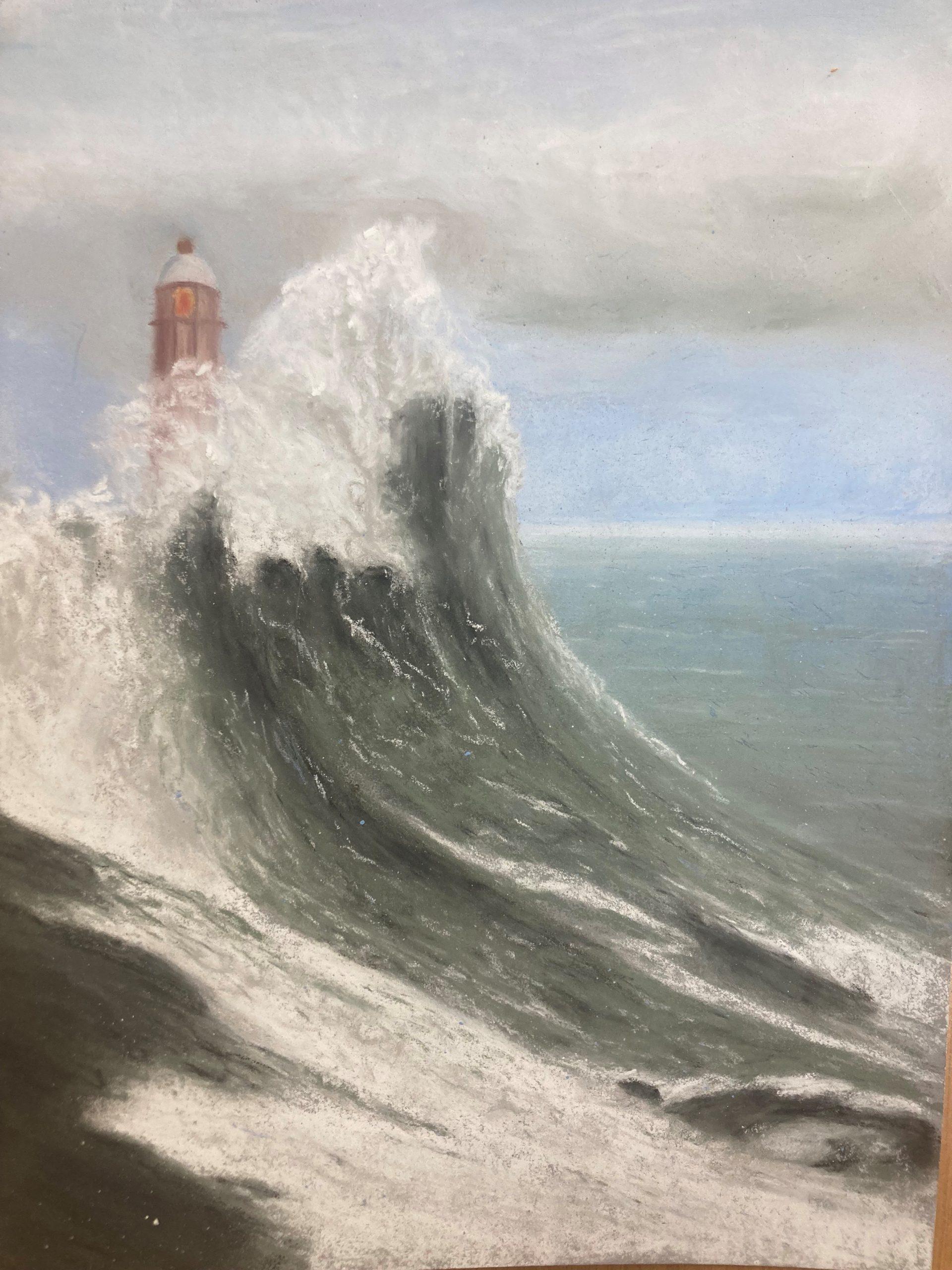
Carol Ellerby
My piece highlight the effect of rising sea levels. I explored using pastels on Pastelmat paper to produce this piece.

Teresa Smith
How reindeer help fight climate change: Reindeer have important jobs, helping the climate, by gobbling up shrubs, they help increase the reflectivity of snow and ice. In the warmer months the reindeer roam freely and feed on lichen and other plants, trampling the ground as they go. In the process they prevent the growth of woody shrubs. Research suggests that shrubs trap heat that thaw the permafrost and warm up the tundra. They way reindeer graze is also having an impact on the albedo effect, which is the capacity of the snow and ice to reflect heat. Research suggests that shrubs speed up the snowmelt in the spring, as they trap heat and generate warmth through their dark twigs extending above the snow. By removing shrubs, reindeer may help slow the melt, preserving the snow cover and it’s important sunlight-reflecting, cooling effect. Source – BBC Future Plane.
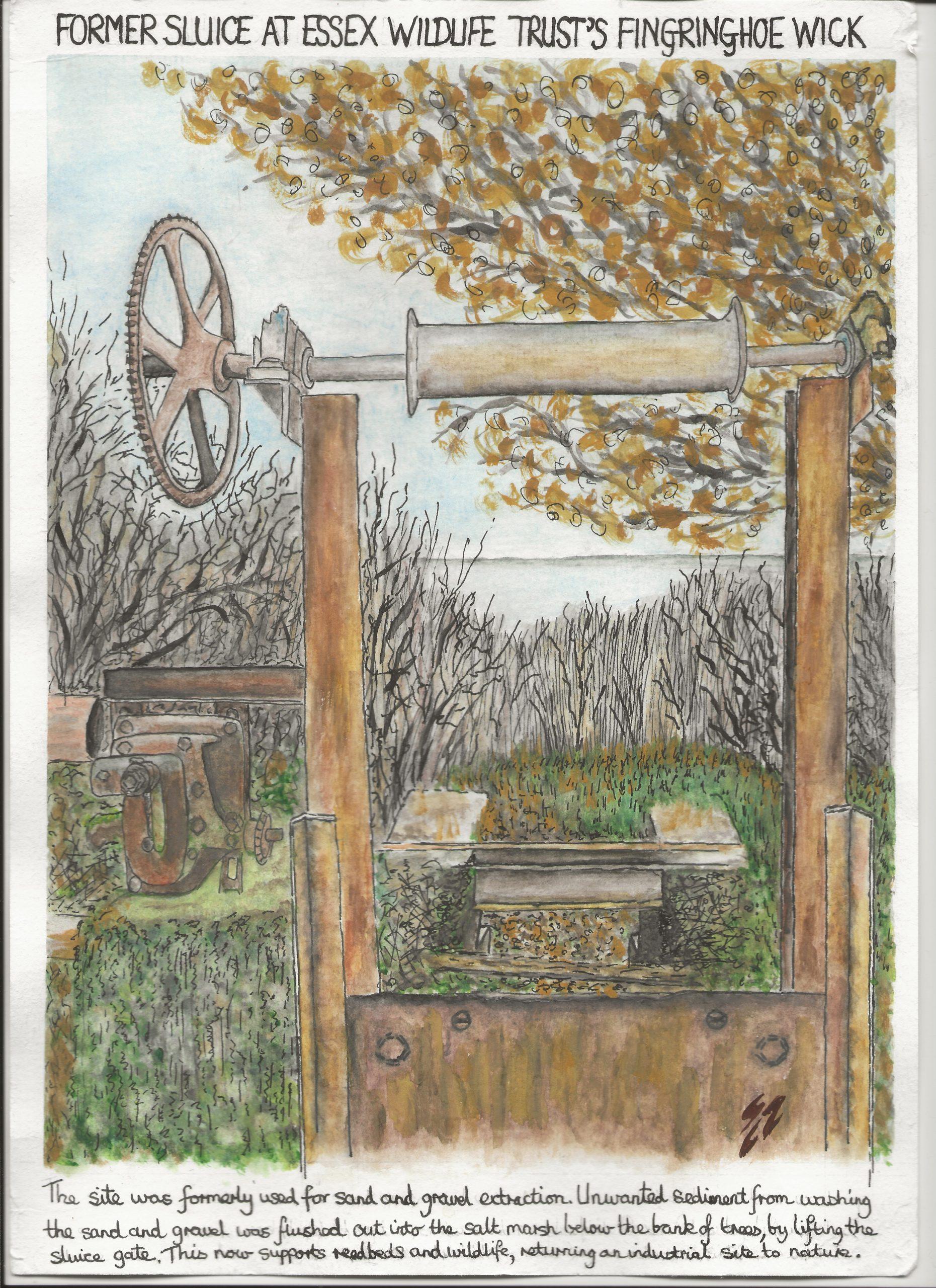
Sarah Stockings
My painting is of the former sluice gate at Essex Wildlife Trust`s Fingringhoe Wick site. The site was formerly used for sand and gravel extraction. Unwanted sediment from washing the sand and gravel was flushed out into the salt marsh of the River Colne below the bank of trees, by lifting the sluice gate. This deep layer of wet sediment now supports reedbeds and wildlife, returning an industrial site to nature.
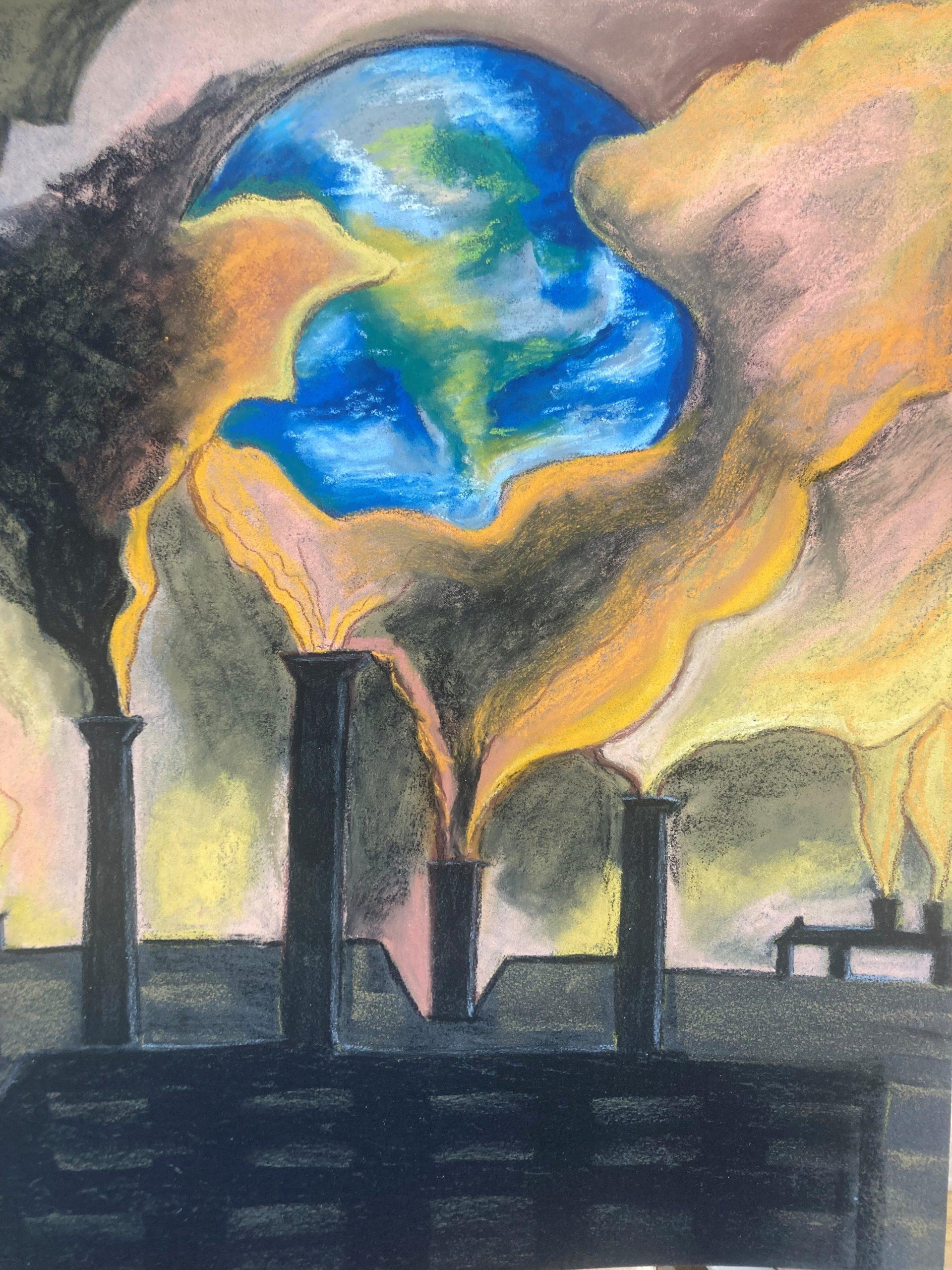
Helen Anderson
I was inspired by a piece of artwork I saw – I think it captures the damage that climate change is doing to the planet.
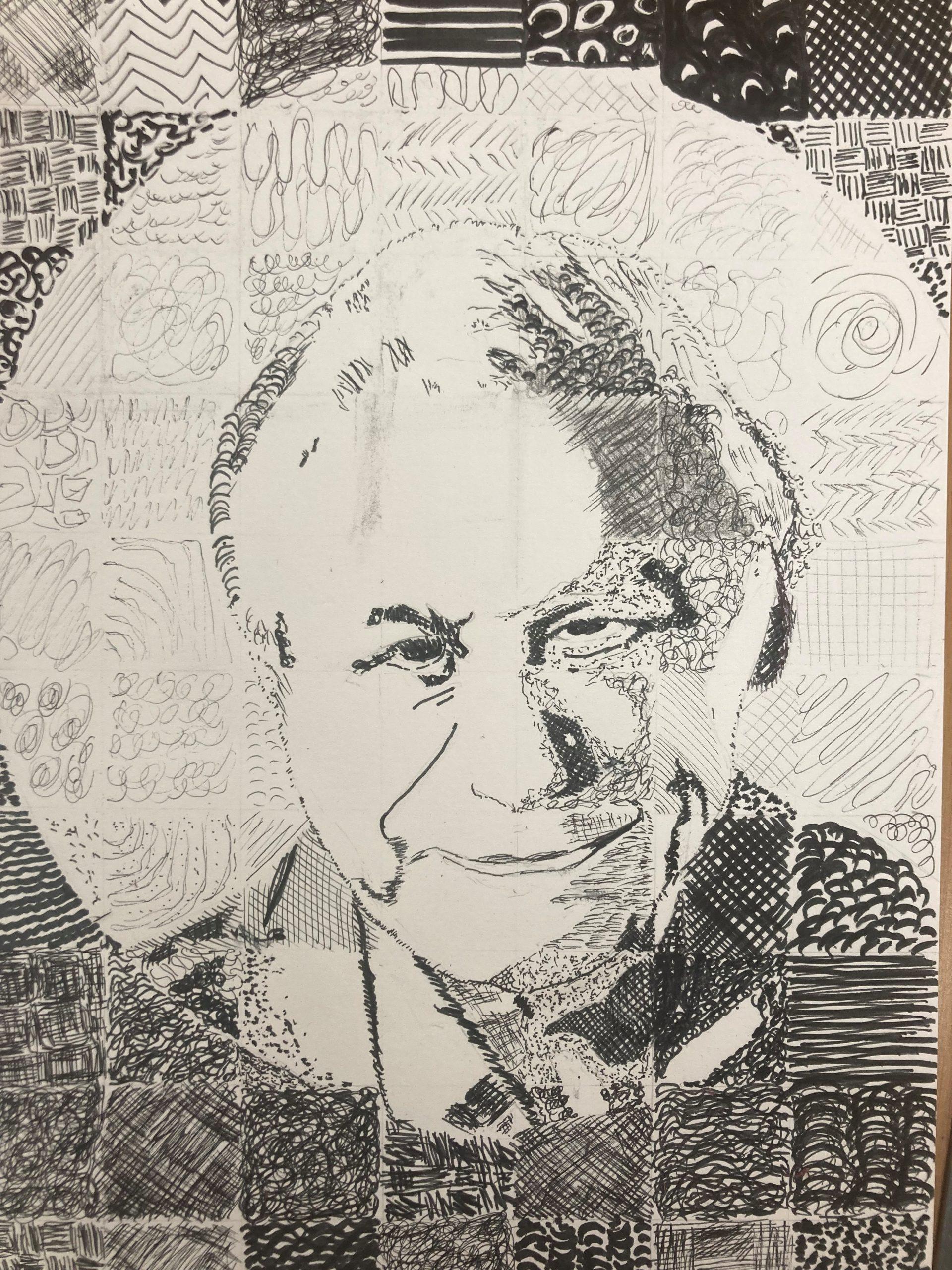
Joan Adams
A portrait of David Attenborough using pen.

Yumiko Rainer
This is a portrait of Wangsri Maathai. She is green activist who founded the Green Belt Movement. I have used representations of trees as background.
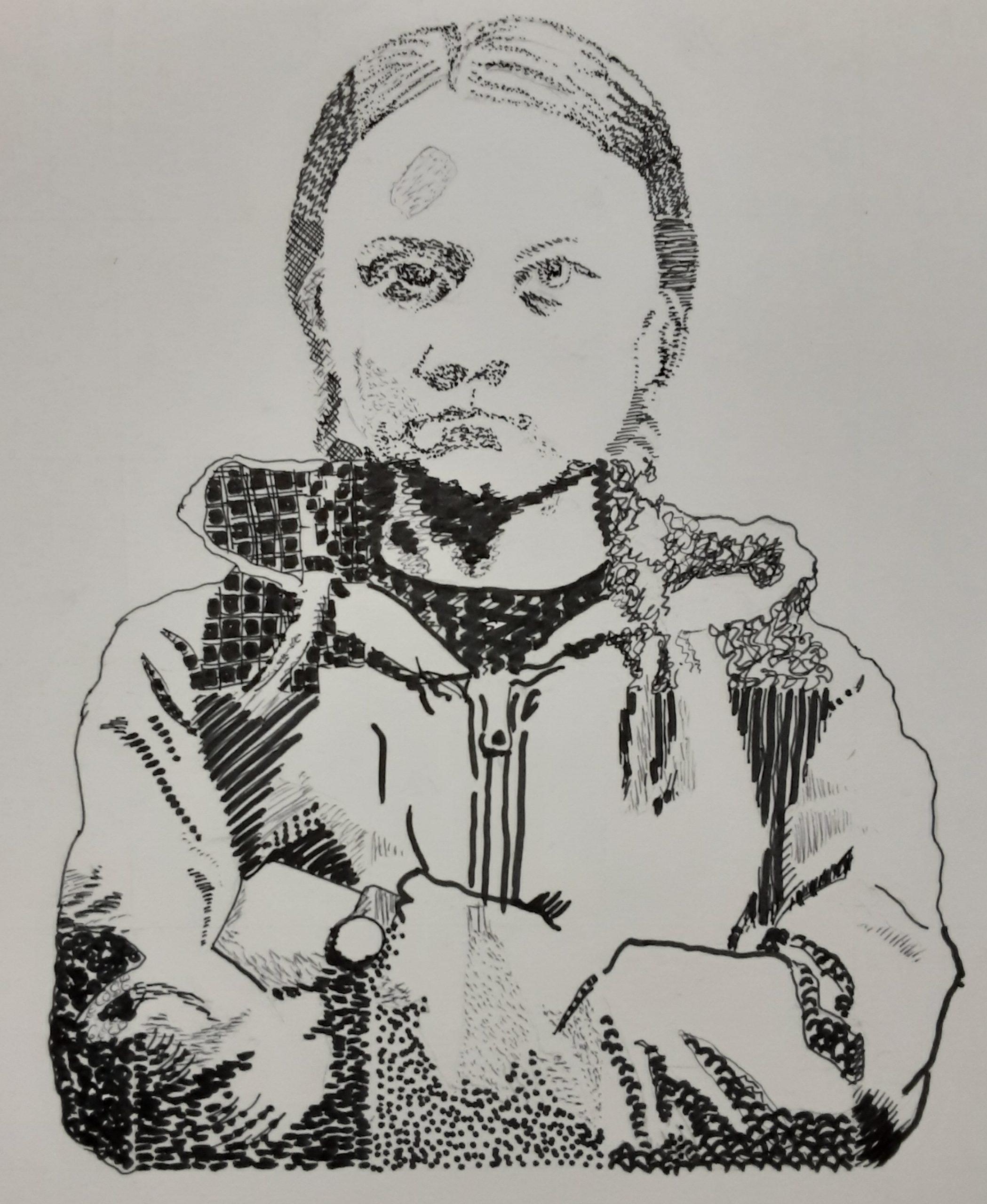
Melanie Isabel Ferris
Mosaic block portrait of climate activist Greta Thunberg, in fine liner and Biro.
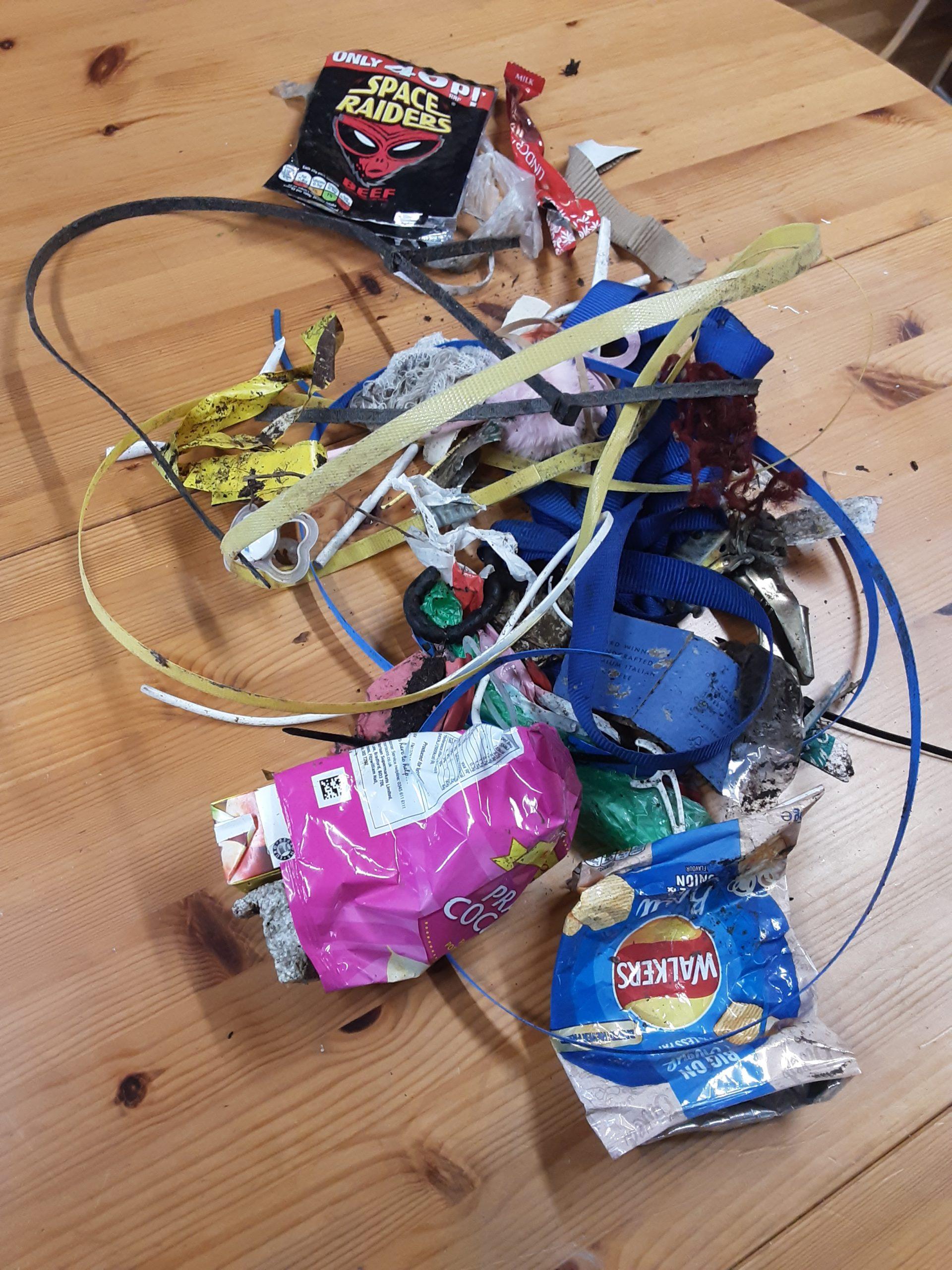
Melanie Isabel Ferris
I have made a bird’s nest to highlight habitat loss for hedgerow birds. I went for an afternoon walk round the lanes near me and collected discarded litter from the ditches and gutters. There are crisp packets, straws, parcel strapping, cable ties, and webbing. All the material in the nest was sourced from that one walk.
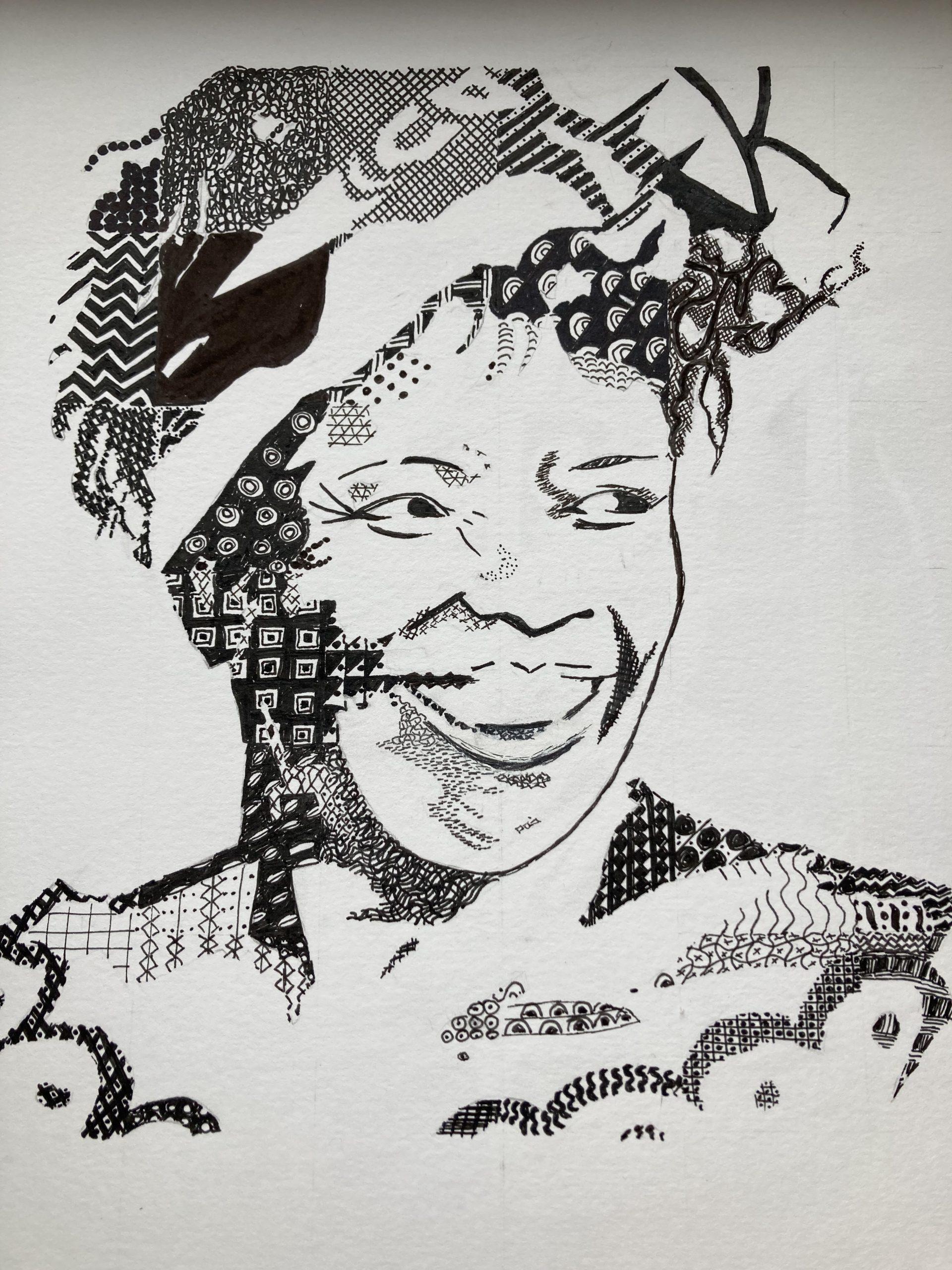
Janet Howcroft
Wangari Muta Maathai was a Kenyan ecologist who founded the Green Belt Movement, responsible for planting 50 million trees across Africa. She was the first African woman to be awarded the Nobel Peace Prize.
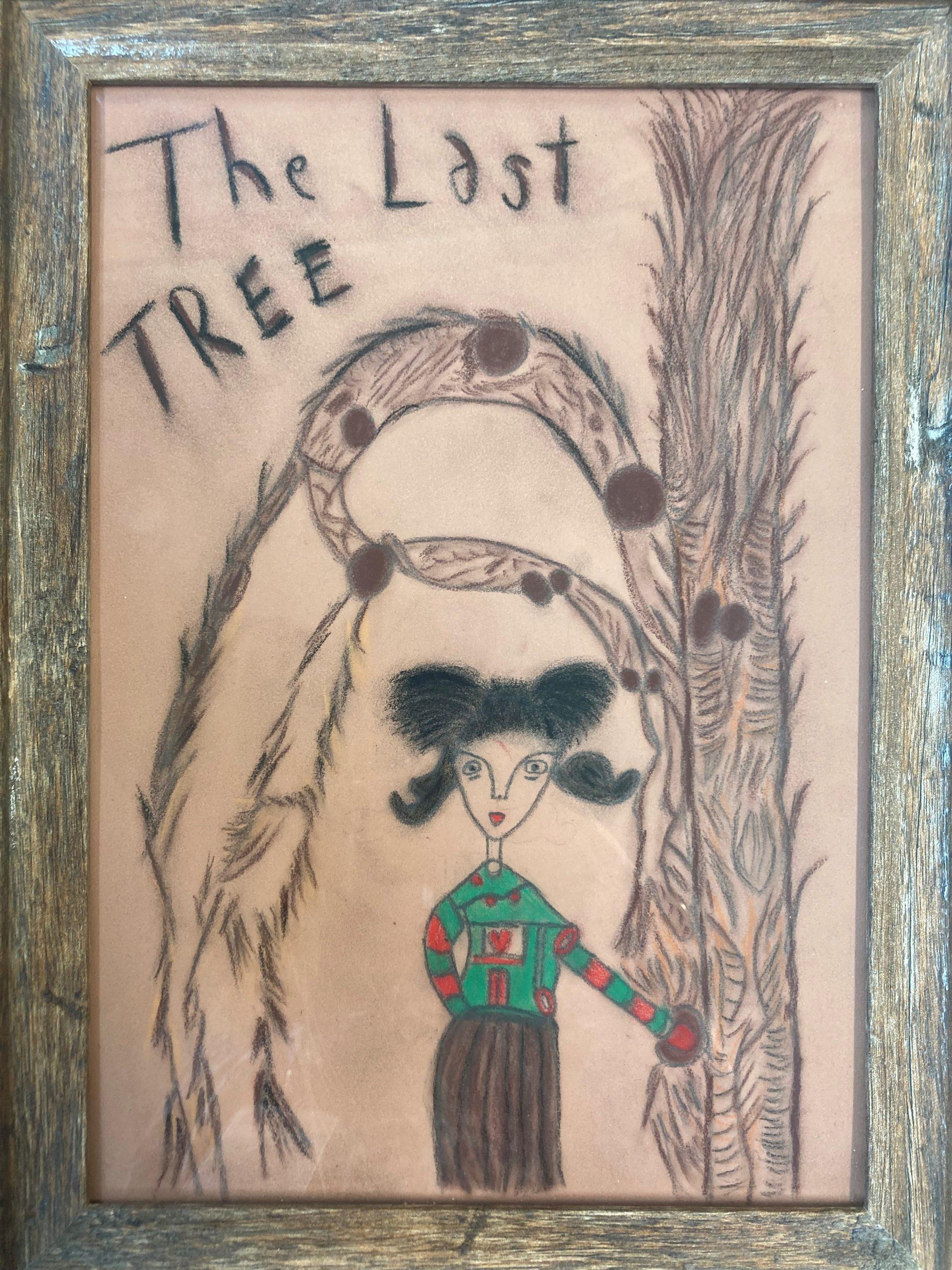
Maureen King
My piece depicts the effect that climate change will have on our children and future generations. It shows the devastation that the loss of trees will have on future generations.
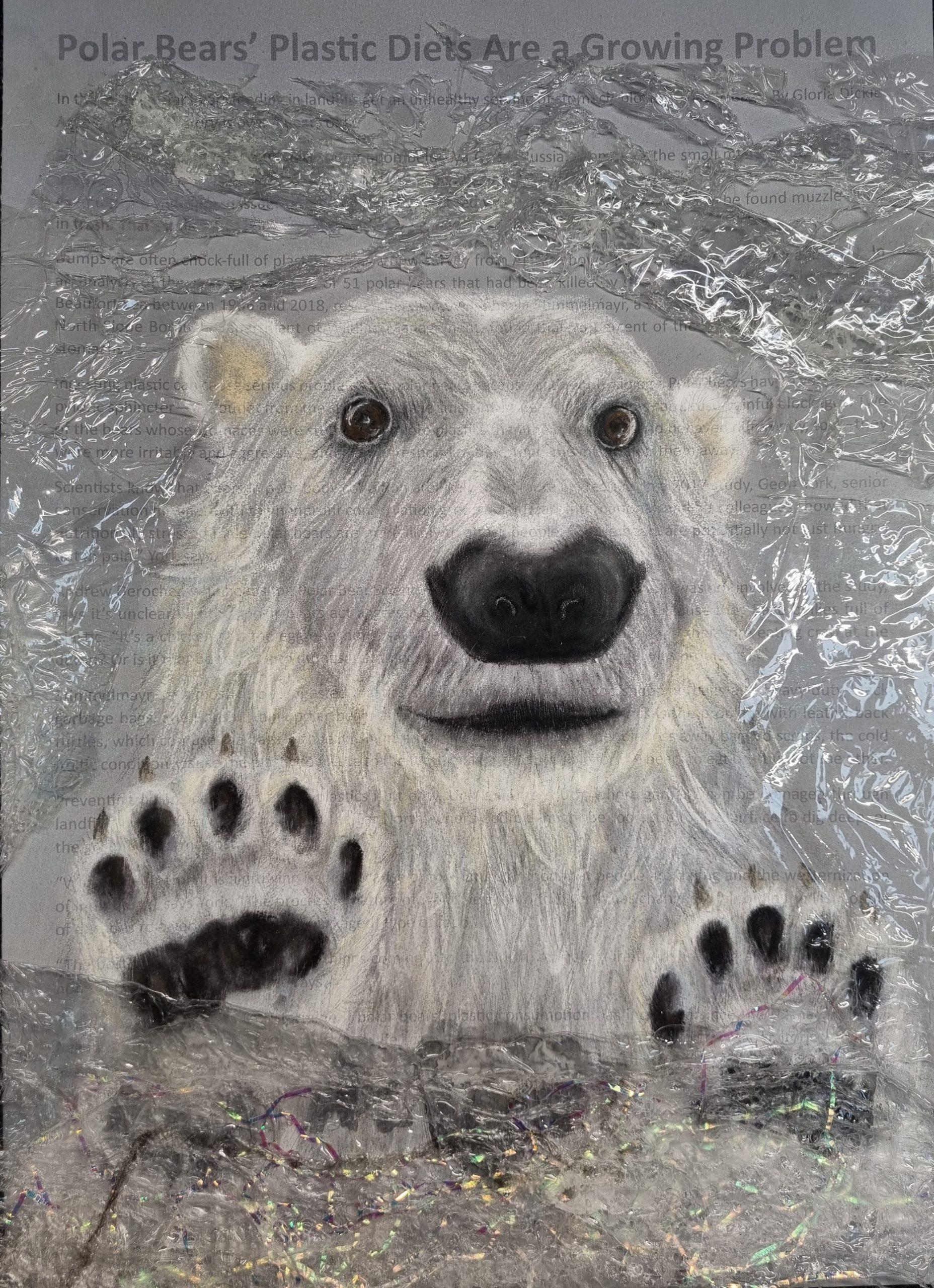
Kelly Southgate
As my background, I have chosen a news article reporting on how plastic consumption is seriously endangering Polar Bears. My bear is drawn using soft pastels and he is framed by melted plastic. His stance is indicates that he is trapped by plastic internally and externally, both in his physical environment and by his diet.

Sue Sharp
My pieces of experimental tie dye inspired me to choose to highlight the plight of the destruction of coral reefs through rising temperatures caused by climate change. My piece shows the transition from the brightly coloured coral to the dying dark reef. All the materials used were leftover scraps and saved items that ‘could always come in handy!
Other Creative Courses
Come and explore drawing and painting, discovering key techniques to develop your own artistic style.
An introduction to the ancient technique of silk painting. Use a range of techniques to create some beautiful luxurious fabrics.
Art Watercolour Painting Taster
A little taster to give you ideas and tips to begin your watercolour painting adventure.
Overcome your fear of drawing in this introduction to the skill.
Learn to produce a variety of traditional and contemporary arrangements suitable for both informal and formal occasions.
Discover watercolours to paint imaginatively and explore the subtle qualities of this medium.
A taster of working with the medium of pastels and how to infuse them effectively with other drawing and painting media.
Stained Glass Developing Skills Workshop
Develop your design skills and knowledge, creating beautiful items in stained glass.
Recycling Plastics In Textiles Workshop
This workshop will explore a range of fusing techniques using recycled plastics to create fabrics to stitch onto.
Pottery For All – Consolidate Your Skills
Consolidate your skills of handbuilding pottery techniques and various decorating techniques to produce bespoke items.
Feedback
"*" indicates required fields
Follow us on social media
Subscribe to the Creative & Cultural Newsletter





